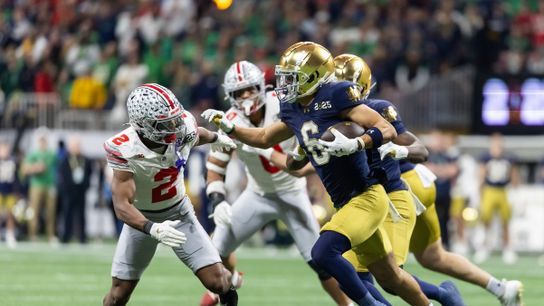Did you feel different when you woke up this morning? The air taste sweeter, the sky a little brighter? Okay, probably not, but we all rose to a different world than the one we left yesterday, and I'm not talking about Delaware and Missouri State becoming FBS's 135th and 136th teams. The House settlement is now the law of the land in college athletics (at least, until the first court challenge, and then the rubber will really meet the road). The long-awaited guardrails are finally here; it remains to be seen how sturdy they are.
With schools now permitted to share revenue directly with athletes, the payment clearinghouse Opendorse released its data on how schools plan to dole out money to their athletes.

Keeping in mind these are averages, here's how the above chart breaks down in real dollars.
-- Power 4 football: $13.448 million
-- Power 4 men's basketball: $4.1615 million
-- Power 4 women's basketball: $1.353 million
-- Power 4, rest of athletics department: $1.5375 million
-- Group of 6 football: $2.6617 million
-- Group of 6 men's basketball: $920,200
-- Group of 6 women's basketball: $404,200
-- Group of 6, rest of athletics department: $313,900
-- FCS football: $1.3104 million
-- Division I men's basketball: $2.6592 million
-- Division I women's basketball: $484,800
-- Division I, rest of athletics department: $350,400
That third chart comes with an entire shaker's worth of salt. Non-football Division I schools run the gamut from tiny schools like the University of New Orleans ($2.56 million in total revenue in the most recent year on record, 232nd of 232 on USA Today's database) and legitimate basketball powers like Gonzaga and St. John's, who draw 20,000 a night and don't have football programs to share money with.
Speaking of football, here's a position-by-position of the average Power 4 revenue share in football -- and again, keep in mind, this is purportedly for the entire room, not just the starter(s):
-- Quarterbacks: $2.27 million
-- Wide receivers: $2.07 million
-- Offensive line: $1.91 million
-- Defensive line: $1.84 million
-- Secondary: $1.75 million
-- Linebackers: $1.6 million
-- Running backs: $1.2 million
-- Tight ends: $605,000
-- Specialists: $202,000
The question now becomes, will roughly $13.5 million be enough for a roster of 85-to-105 scholarship football players to live on? The schools don't think so, and these chart are the proof.
In the final month before Deloitte's NIL Go payment arbitrating system got up and running, collectives emptied out their coffers to pay athletes.

So, is that it for the "Now It's Legal" de-facto roster payments from collectives to athletes? Not quite.

A few thoughts:
1) A system repeatedly described as "unsustainable" seemed to be sustaining just fine. According to Opendorse's numbers, collective payments grew from $321.3 million in 2021-22, the first year of the new system, to $1.3 billion in 2024-25. Seems pretty sustainable to me.
2) Opendorse anticipates schools successfully offloading payments from collectives into the commercial market. While collective payments are expected to collapse from $1.3 billion in 2024-25 to a paltry $77.9 million by 2028-29, commercial payments are anticipated to grow from $957.4 million to $1.3 billion over that same span, while collegiate rev-share grows from nothing, to $1.5 billion, to $1.8 billion.
3) To answer my own question above, no, Power 4 football teams aren't expected to live on $13.5 million for the 2025 football season. Recall the summer of 2022 when Ryan Day sent murmurs across the college football world when he told a gathering of Columbus business leaders that it would take $13 million to build a championship-level roster for that season. The Wall Street Journal reports Ohio State now expects its football team to earn $35 million for the 2025 season.
Like a number of schools, Texas's collective, the Texas One Fund, announced Tuesday it is continuing operations and adapting to the new, post-House world. "Texas One is ready to expand its model, enhancing our for-profit operations and driving promotional opportunities for our sponsors and partners."
Here is the email @TexasOneFund just sent out to donors detailing how it plans to operate in the House era pic.twitter.com/80sBee30M9
— Joe Cook (@josephcook89) July 1, 2025
At the same time, the Texas athletics department partnered with its multimedia vendor, Learfield, to form the Longhorn Sports Agency to, in layman's terms, get their athletes paid. The entity was created "to optimize NIL operations and maximize opportunities for Longhorn student-athletes," and to "provide student-athletes with enhanced access to resources for brand development, strategic content creation, and customized NIL solutions."
Texas is not the first, nor the last, school to re-structure its athletics department in such a way. As Texas AD Chris Del Conte jokes, R&D in college athletics stands for "rip off and duplicate."
What will the climate of college athletics look like on July 1, 2029? Anyone who tells you they know definitively is lying. But with the sun rising on a new dawn, there's a forecast from those on the front lines.
